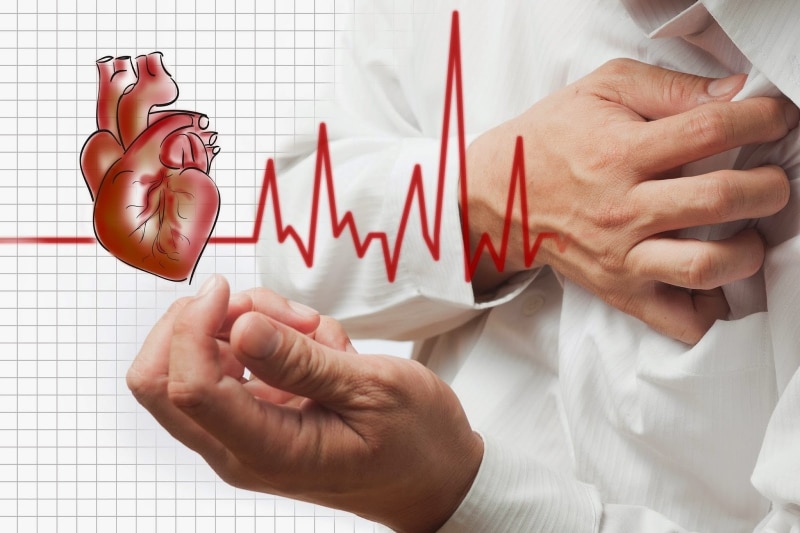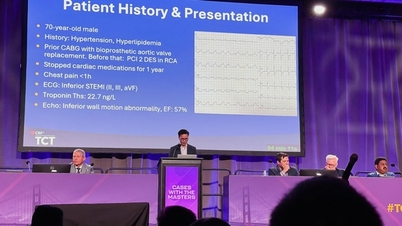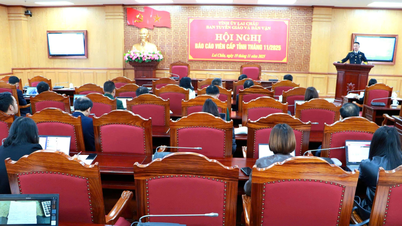Medical news October 20: Be alert to cardiovascular, kidney, and metabolic diseases
Dr. Nguyen Trong Khoa, Deputy Director of the Department of Medical Examination and Treatment Management, said that cardiovascular-renal-metabolic diseases are currently a matter of special concern.
Beware of cardiovascular, kidney, and metabolic diseases
According to Mr. Khoa, with the number of diabetic patients in the world reaching 537 million people, heart failure patients over 60 million people and especially chronic kidney patients over 850 million people. This is a burden of disease to the health of the people and the health system of each country.
 |
| Cardiovascular-renal-metabolic diseases are of particular concern today. |
The combination of cardiovascular, renal and metabolic diseases is becoming a major challenge in modern medicine. These diseases not only increase the burden of disease on the health system but also seriously affect the quality of life of patients and their families, especially the elderly who have many diseases at the same time that need care and treatment.
The leader of the Department of Medical Examination and Treatment Management said that in recent years, the Ministry of Health has been making efforts to promote programs to prevent, control and manage non-communicable diseases, including cardiovascular, kidney and urinary diseases and metabolic disorders.
Diagnostic guidelines for cardiovascular, endocrine-diabetic, and renal diseases have been issued quite comprehensively and are regularly updated, helping medical examination and treatment facilities have practical documents and improve the quality of disease management and treatment.
However, current reality requires us to have a more comprehensive and multidimensional approach, especially interdisciplinary coordination between cardiovascular, nephrology and endocrinology specialties.
Dr. Duong Huy Lieu, Chairman of the Association of Health Economics, also said that cardiovascular-renal-metabolic diseases often co-exist and promote each other, making the patient's prognosis worse, while also creating an additional burden on diagnosis, treatment, and the health system if not screened, detected, treated, and managed comprehensively in all three aspects.
More information about the burden of cardiovascular disease, according to Professor, Dr. Nguyen Thi Thu Hoai, Deputy Director of the Vietnam Heart Institute, cardiovascular-renal-metabolic diseases often seriously reduce the patient's life expectancy, especially if they coexist.
Diabetes and hypertension are responsible for more than 80% of end-stage renal disease (ESKD) globally. Cardiovascular disease affects 40% of diabetic patients, and at least 30% of diabetic patients have cardiovascular disease.
Cardiac dysfunction adds to the renal and metabolic burden. Cardiac abnormalities influence the progression and outcome of renal and metabolic disease.
In Vietnam, 55% of type 2 diabetes patients have complications, the cost of treating complications accounts for 70% of the total cost of treating diabetes patients, and among the complications, treatment of cardiovascular complications accounts for the largest cost.
More emergency cases, near death due to drinking alkaline water to cure diseases
Bach Mai Hospital informed that recently, it has received many patients poisoned by drinking alkaline water for medical treatment. A typical example is patient PTM (60 years old, Tan Dan, Soc Son, Hanoi), who was admitted to the hospital in a state of exhaustion, weak limbs, vomiting for many days without stopping, vomiting gastric juice and bile.
The patient was transferred to the Poison Control Center, Bach Mai Hospital with a diagnosis of alkaline water poisoning, metabolic alkalosis, and hypokalemia. Patient M's blood test results clearly showed many abnormal indicators.
According to the patient, due to many diseases of the stomach, duodenum, colon, thyroid tumor, numbness in hands and feet... when hearing the villagers spread the word about the address of the water that cures all diseases right in the area, Mrs. M also went there and asked to be treated.
“There, they do not examine you but only ask about your condition and are instructed to treat you by drinking water from a filter every day, maybe adding a little salt to make it easier to drink and not eating anything. Drink at least 5-6 liters of water a day, for about 10-15 days,” Ms. M said about the treatment regimen.
However, after less than 5 days of drinking water and fasting, Ms. M could not stand, started vomiting continuously, and had to be hospitalized for emergency care.
Previously, Bach Mai Hospital had received a group of patients who also used a type of water introduced as alkaline water to treat their illness.
These three patients with kidney failure were undergoing periodic hemodialysis at Lai Chau General Hospital, but stopped dialysis and went to Thanh Oai to drink water to cure their illness in the same way as patient M in Soc Son: drinking 6 liters of water a day, fasting completely for 15-20 days. However, after only drinking for about 2-3 days, these patients had difficulty breathing and fell into a coma and had to be taken to the emergency room.
Patients with impaired consciousness, respiratory failure, severe myocardial injury, acute pulmonary edema due to fluid overload complications on the basis of chronic renal failure were intubated, ventilated, and given emergency dialysis immediately upon admission.
It is worth mentioning that the test results of the amount of Urea, Potassium and Creatinine in the blood increased very high: Urea 3 times higher than normal, Creatinine 10-15 times higher than normal.
These patients were fortunate to receive timely dialysis, avoiding death, being treated until stable and returning to a regular dialysis schedule to maintain health and life.
Angina pectoris warns of dangerous disease
The man suddenly had left chest pain that spread to his arm and worsened with exertion. When admitted to the hospital, the doctor diagnosed him with coronary artery stenosis.
Mr. PVT, 64 years old (residing in Quang Ninh), was taken to Bai Chay Hospital (Quang Ninh) for emergency treatment with left chest pain radiating to the arm, the pain increased with exertion.
The results of the examination and coronary angiography showed that the patient had a 90% narrowing of the coronary artery. Master Dinh Danh Trinh, Deputy Head of the Cardiology Department, and his team intervened to place two stents in the narrowed section. After the intervention, the patient's health was stable.
Doctor Trinh said that unstable angina occurs due to a sudden decrease in coronary blood flow to the heart muscle, often due to atherosclerosis leading to partial or complete blockage of the lumen of the blood vessel.
Symptoms of unstable angina are more severe and last longer. Angina attacks tend to occur more frequently and increase in intensity.
Unstable angina can lead to myocardial infarction and threaten the patient's life if not treated promptly.
There are many factors that increase the risk of unstable angina, such as smoking, people with atherosclerosis, brittle and stiff arteries, people with a history of high blood pressure, diabetes, obesity, etc. In addition, age, gender, and race also create risks of unstable angina.
To prevent unstable angina as well as coronary artery disease, Dr. Trinh recommends that people need to build a healthy lifestyle, not use alcohol, tobacco and stimulants. Have a reasonable work and rest plan, avoid stress; follow a scientific diet with full nutrition;
Exercising every day helps to improve health, increase resistance; maintain a reasonable weight, avoid being overweight or obese. In particular, unlike stable angina, unstable angina can occur at any time before a heart attack occurs. If not treated well, the patient will have a high risk of not surviving.
Therefore, when seeing signs of unstable angina, patients should see a doctor to find out the cause and determine the exact health condition for timely intervention.



![[Photo] Lam Dong: Panoramic view of Lien Khuong waterfall rolling like never before](/_next/image?url=https%3A%2F%2Fvphoto.vietnam.vn%2Fthumb%2F1200x675%2Fvietnam%2Fresource%2FIMAGE%2F2025%2F11%2F20%2F1763633331783_lk7-jpg.webp&w=3840&q=75)
![[Photo] National Assembly Chairman Tran Thanh Man holds talks with South Korean National Assembly Chairman Woo Won Shik](/_next/image?url=https%3A%2F%2Fvphoto.vietnam.vn%2Fthumb%2F1200x675%2Fvietnam%2Fresource%2FIMAGE%2F2025%2F11%2F20%2F1763629724919_hq-5175-jpg.webp&w=3840&q=75)


![[Photo] President Luong Cuong receives President of the Senate of the Czech Republic Milos Vystrcil](/_next/image?url=https%3A%2F%2Fvphoto.vietnam.vn%2Fthumb%2F1200x675%2Fvietnam%2Fresource%2FIMAGE%2F2025%2F11%2F20%2F1763629737266_ndo_br_1-jpg.webp&w=3840&q=75)



































































































Comment (0)